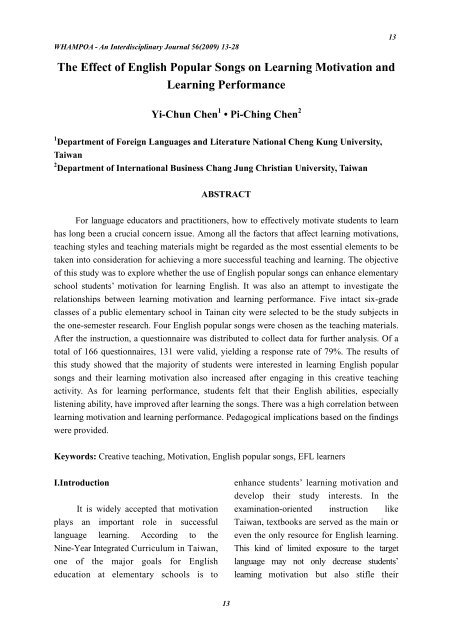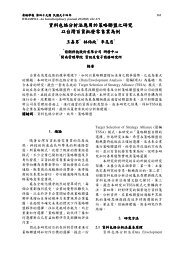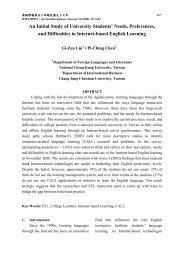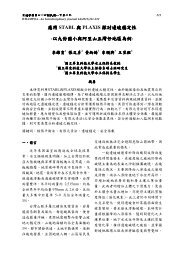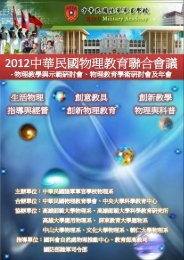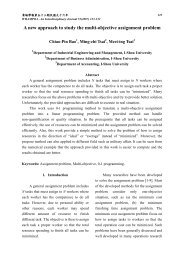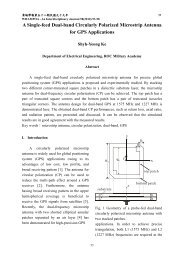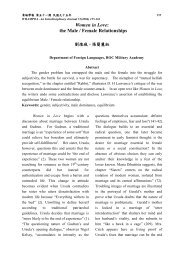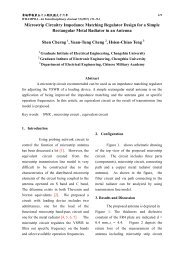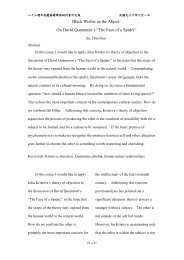The Effect of English Popular Songs on Learning Motivation and ...
The Effect of English Popular Songs on Learning Motivation and ...
The Effect of English Popular Songs on Learning Motivation and ...
You also want an ePaper? Increase the reach of your titles
YUMPU automatically turns print PDFs into web optimized ePapers that Google loves.
13WHAMPOA - An Interdisciplinary Journal 56(2009) 13-28<str<strong>on</strong>g>The</str<strong>on</strong>g> <str<strong>on</strong>g>Effect</str<strong>on</strong>g> <str<strong>on</strong>g>of</str<strong>on</strong>g> <str<strong>on</strong>g>English</str<strong>on</strong>g> <str<strong>on</strong>g>Popular</str<strong>on</strong>g> <str<strong>on</strong>g>S<strong>on</strong>gs</str<strong>on</strong>g> <strong>on</strong> <strong>Learning</strong> Motivati<strong>on</strong> <strong>and</strong><strong>Learning</strong> PerformanceYi-Chun Chen 1 • Pi-Ching Chen 21 Department <str<strong>on</strong>g>of</str<strong>on</strong>g> Foreign Languages <strong>and</strong> Literature Nati<strong>on</strong>al Cheng Kung University,Taiwan2 Department <str<strong>on</strong>g>of</str<strong>on</strong>g> Internati<strong>on</strong>al Business Chang Jung Christian University, TaiwanABSTRACTFor language educators <strong>and</strong> practiti<strong>on</strong>ers, how to effectively motivate students to learnhas l<strong>on</strong>g been a crucial c<strong>on</strong>cern issue. Am<strong>on</strong>g all the factors that affect learning motivati<strong>on</strong>s,teaching styles <strong>and</strong> teaching materials might be regarded as the most essential elements to betaken into c<strong>on</strong>siderati<strong>on</strong> for achieving a more successful teaching <strong>and</strong> learning. <str<strong>on</strong>g>The</str<strong>on</strong>g> objective<str<strong>on</strong>g>of</str<strong>on</strong>g> this study was to explore whether the use <str<strong>on</strong>g>of</str<strong>on</strong>g> <str<strong>on</strong>g>English</str<strong>on</strong>g> popular s<strong>on</strong>gs can enhance elementaryschool students’ motivati<strong>on</strong> for learning <str<strong>on</strong>g>English</str<strong>on</strong>g>. It was also an attempt to investigate therelati<strong>on</strong>ships between learning motivati<strong>on</strong> <strong>and</strong> learning performance. Five intact six-gradeclasses <str<strong>on</strong>g>of</str<strong>on</strong>g> a public elementary school in Tainan city were selected to be the study subjects inthe <strong>on</strong>e-semester research. Four <str<strong>on</strong>g>English</str<strong>on</strong>g> popular s<strong>on</strong>gs were chosen as the teaching materials.After the instructi<strong>on</strong>, a questi<strong>on</strong>naire was distributed to collect data for further analysis. Of atotal <str<strong>on</strong>g>of</str<strong>on</strong>g> 166 questi<strong>on</strong>naires, 131 were valid, yielding a resp<strong>on</strong>se rate <str<strong>on</strong>g>of</str<strong>on</strong>g> 79%. <str<strong>on</strong>g>The</str<strong>on</strong>g> results <str<strong>on</strong>g>of</str<strong>on</strong>g>this study showed that the majority <str<strong>on</strong>g>of</str<strong>on</strong>g> students were interested in learning <str<strong>on</strong>g>English</str<strong>on</strong>g> populars<strong>on</strong>gs <strong>and</strong> their learning motivati<strong>on</strong> also increased after engaging in this creative teachingactivity. As for learning performance, students felt that their <str<strong>on</strong>g>English</str<strong>on</strong>g> abilities, especiallylistening ability, have improved after learning the s<strong>on</strong>gs. <str<strong>on</strong>g>The</str<strong>on</strong>g>re was a high correlati<strong>on</strong> betweenlearning motivati<strong>on</strong> <strong>and</strong> learning performance. Pedagogical implicati<strong>on</strong>s based <strong>on</strong> the findingswere provided.Keywords: Creative teaching, Motivati<strong>on</strong>, <str<strong>on</strong>g>English</str<strong>on</strong>g> popular s<strong>on</strong>gs, EFL learnersІ.Introducti<strong>on</strong>It is widely accepted that motivati<strong>on</strong>plays an important role in successfullanguage learning. According to theNine-Year Integrated Curriculum in Taiwan,<strong>on</strong>e <str<strong>on</strong>g>of</str<strong>on</strong>g> the major goals for <str<strong>on</strong>g>English</str<strong>on</strong>g>educati<strong>on</strong> at elementary schools is toenhance students’ learning motivati<strong>on</strong> <strong>and</strong>develop their study interests. In theexaminati<strong>on</strong>-oriented instructi<strong>on</strong> likeTaiwan, textbooks are served as the main oreven the <strong>on</strong>ly resource for <str<strong>on</strong>g>English</str<strong>on</strong>g> learning.This kind <str<strong>on</strong>g>of</str<strong>on</strong>g> limited exposure to the targetlanguage may not <strong>on</strong>ly decrease students’learning motivati<strong>on</strong> but also stifle their13
<str<strong>on</strong>g>The</str<strong>on</strong>g> <str<strong>on</strong>g>Effect</str<strong>on</strong>g> <str<strong>on</strong>g>of</str<strong>on</strong>g> <str<strong>on</strong>g>English</str<strong>on</strong>g> <str<strong>on</strong>g>Popular</str<strong>on</strong>g> <str<strong>on</strong>g>S<strong>on</strong>gs</str<strong>on</strong>g> <strong>on</strong> <strong>Learning</strong> 17Motivati<strong>on</strong> <strong>and</strong> <strong>Learning</strong> Performancefosters creativity” is the <strong>on</strong>e that agrees withwhat our government has been advocating.In 2002 the Ministry <str<strong>on</strong>g>of</str<strong>on</strong>g> Educati<strong>on</strong> regulated<str<strong>on</strong>g>The</str<strong>on</strong>g> White Paper <strong>on</strong> Creative Educati<strong>on</strong>.Teachers at all levels <str<strong>on</strong>g>of</str<strong>on</strong>g> different disciplinesare encouraged to seek innovative ways toimprove the effectiveness <str<strong>on</strong>g>of</str<strong>on</strong>g> teaching <strong>and</strong>learning. That is, creative teaching is highlyvalued.Creative teaching refers to teachingthat results from the teacher’s creativity, notto teaching that is intended to develop thelearner’s creativity. Even so, creativeteaching enhances students’ performance(Schacter, Thum, & Zikfin, 2006).According to Chiu (2007), creative teachingcan be understood by four renowned Ps <str<strong>on</strong>g>of</str<strong>on</strong>g>creativity: pers<strong>on</strong>, process, product <strong>and</strong>place/envir<strong>on</strong>ment. Envir<strong>on</strong>ment can beseen as the most comprehensive element, forit can work as a provider <str<strong>on</strong>g>of</str<strong>on</strong>g> resources orc<strong>on</strong>straints. Without the envir<strong>on</strong>mentalsupport, a learner may not have the chanceto display his or her creativity within. <str<strong>on</strong>g>The</str<strong>on</strong>g>physical envir<strong>on</strong>ment is <strong>on</strong>e aspect <str<strong>on</strong>g>of</str<strong>on</strong>g>learning. By building a creative learningspace, it is found that students become moreactive in the learning process (Jankowska &Atlay, 2008). Moreover, an appropriateatmosphere that makes students enjoylearning is also important. <str<strong>on</strong>g>The</str<strong>on</strong>g> pers<strong>on</strong>, thatis, teachers are <strong>on</strong>e crucial comp<strong>on</strong>ent <str<strong>on</strong>g>of</str<strong>on</strong>g>students’ learning envir<strong>on</strong>ment.Teachers can exert an influence <strong>on</strong>students through their own acti<strong>on</strong>s. If a topicis presented in more interesting ways, it islikely that students care more about the topic.<str<strong>on</strong>g>The</str<strong>on</strong>g> use <str<strong>on</strong>g>of</str<strong>on</strong>g> positive emoti<strong>on</strong>s in theclassroom is essential to learning. “Fun” as<strong>on</strong>e <str<strong>on</strong>g>of</str<strong>on</strong>g> the positive emoti<strong>on</strong>s is veryimportant for young learners <strong>and</strong> theemoti<strong>on</strong>al reacti<strong>on</strong> caused by the nature <str<strong>on</strong>g>of</str<strong>on</strong>g>an event is what makes an event memorable(Gilbert, 2002). For example, novelty is amotivating factor that stimulates the learningpotential <str<strong>on</strong>g>of</str<strong>on</strong>g> learners. <str<strong>on</strong>g>The</str<strong>on</strong>g>refore, to makestudents more engaged in learning, bringingin some variety or material which is leastexpected from time to time might be a goodchoice.2.3 <str<strong>on</strong>g>S<strong>on</strong>gs</str<strong>on</strong>g> in Language TeachingFor young EFL learners, carefullychosen materials are quite important.Am<strong>on</strong>g all the materials used in class, s<strong>on</strong>gsare <str<strong>on</strong>g>of</str<strong>on</strong>g> great value. <str<strong>on</strong>g>The</str<strong>on</strong>g>y can provide asubstantial amount <str<strong>on</strong>g>of</str<strong>on</strong>g> auditory input, <strong>and</strong>which is most important at early languagelearning stage. Much previous research hasprovided insights into the advantages <str<strong>on</strong>g>of</str<strong>on</strong>g>learning <str<strong>on</strong>g>English</str<strong>on</strong>g> through s<strong>on</strong>gs in theclassroom (Schoepp, 2001; Mora, 2000; Liu,2006). For helping learners to develop theirmultiple intelligences, Simps<strong>on</strong> (2000) believesthat through well-planned teaching activities,linguistic intelligence <strong>and</strong> musicalintelligence can benefit each other.Teachers may adopt s<strong>on</strong>gs in the EFLclassroom for many reas<strong>on</strong>s <strong>and</strong> they mainlycome from three different aspects: affective,cognitive <strong>and</strong> linguistic (Schoepp, 2001).First, s<strong>on</strong>gs can create a relaxing,entertaining <strong>and</strong> n<strong>on</strong>-threatening classroomatmosphere in which learners lower theiranxiety filter <strong>and</strong> be more open to learning.Sec<strong>on</strong>d, the nature <str<strong>on</strong>g>of</str<strong>on</strong>g> s<strong>on</strong>gs is repetitive <strong>and</strong>it facilitates automaticity in languagedevelopment process. To combine both17
18 affective <strong>and</strong> unc<strong>on</strong>scious factors together,the power <str<strong>on</strong>g>of</str<strong>on</strong>g> ‘s<strong>on</strong>g-stuck-in- my-head’(SSIMH) phenomen<strong>on</strong> (Murphey, 1990)appears. Singing is an easy way <str<strong>on</strong>g>of</str<strong>on</strong>g>memorizing something <strong>and</strong> melody seems tohelp us retrieve the informati<strong>on</strong> effortlessly.Third, some s<strong>on</strong>gs c<strong>on</strong>sist <str<strong>on</strong>g>of</str<strong>on</strong>g> colloquial<str<strong>on</strong>g>English</str<strong>on</strong>g> which can prepare learners forinformal c<strong>on</strong>versati<strong>on</strong> in real life situati<strong>on</strong>. Inadditi<strong>on</strong> to these three reas<strong>on</strong>s menti<strong>on</strong>edabove, s<strong>on</strong>gs can also be a culturally-richresource <strong>and</strong> easy to be h<strong>and</strong>led in a less<strong>on</strong>(Murphey, 1992).However, some s<strong>on</strong>gs <strong>on</strong> studenttextbooks are very ‘artificial’, that is, theyare composed based <strong>on</strong> the specific sentencepatterns or vocabulary that the students justlearned. <str<strong>on</strong>g>The</str<strong>on</strong>g>refore, sometimes the s<strong>on</strong>gs arenot good <strong>and</strong> this might partly explain whystudents, especially sixth graders, d<strong>on</strong>’t wantto sing at all. Another main reas<strong>on</strong> is thatsixth grade students think that the s<strong>on</strong>gs <strong>on</strong>textbooks are simply too ‘childish’ for them.<str<strong>on</strong>g>The</str<strong>on</strong>g>se days, six-grade students (about 12years old) are more mature than we think.<str<strong>on</strong>g>The</str<strong>on</strong>g>y are just like teenagers who are easilyto be influenced by popular culture.Dom<strong>on</strong>ey <strong>and</strong> Harris (1993) asserted thatpop music was probably the most frequent<strong>and</strong> meaningful exposure to <str<strong>on</strong>g>English</str<strong>on</strong>g> outsidelearners’ <str<strong>on</strong>g>English</str<strong>on</strong>g> classes. <str<strong>on</strong>g>The</str<strong>on</strong>g>refore, populars<strong>on</strong>gs can be effective materials that relate<str<strong>on</strong>g>English</str<strong>on</strong>g> learning to students’ daily life.In c<strong>on</strong>clusi<strong>on</strong> <str<strong>on</strong>g>of</str<strong>on</strong>g> literature review,motivati<strong>on</strong> is essential to language learning<strong>and</strong> <strong>on</strong>e way to increase the learningmotivati<strong>on</strong> is by creative teaching. Hence,the present study centers attenti<strong>on</strong> <strong>on</strong>motivati<strong>on</strong>al aspects <str<strong>on</strong>g>of</str<strong>on</strong>g> using <strong>on</strong>e creativeelement, <str<strong>on</strong>g>English</str<strong>on</strong>g> popular s<strong>on</strong>gs, in EFLclassroom. By c<strong>on</strong>ducting the research, theresearcher hoped to get promising results<strong>and</strong> provide insights into language teaching..Methodology3.1 SubjectsParticipants included 166 six-gradestudents from five classes in an elementaryschool in the northern district <str<strong>on</strong>g>of</str<strong>on</strong>g> Tainan City.However, for students who hadn’tcompleted all the items <strong>on</strong> the questi<strong>on</strong>naireor ticked the same box <strong>on</strong> both Item 14 <strong>and</strong>Item 15, they were excluded from thepresent study. In the end, a total <str<strong>on</strong>g>of</str<strong>on</strong>g> 131six-grade students c<strong>on</strong>stituted the studysubjects, including 62 male students (47.3 %)<strong>and</strong> 69 female <strong>on</strong>es (52.7 %).3.2 MaterialsTo create a more enjoyable learningenvir<strong>on</strong>ment for young learners to learn<str<strong>on</strong>g>English</str<strong>on</strong>g>, a total <str<strong>on</strong>g>of</str<strong>on</strong>g> four <str<strong>on</strong>g>English</str<strong>on</strong>g> populars<strong>on</strong>gs were introduced during the wholesemester. <str<strong>on</strong>g>The</str<strong>on</strong>g> titles were “Seas<strong>on</strong>s in theSun” by Westlife, “You Raise Me Up” byWestlife, “You'll Be In My Heart” by PhilColins as well as “Way Back Into Love” byHugh Grant <strong>and</strong> Haley Bennett. In class, allthose s<strong>on</strong>gs were presented by the CD player.In additi<strong>on</strong>, the teacher also providedstudents with parts <str<strong>on</strong>g>of</str<strong>on</strong>g> the films to introducethe main plots <str<strong>on</strong>g>of</str<strong>on</strong>g> the s<strong>on</strong>gs about “You'll BeIn My Heart” <strong>and</strong> “Way Back Into Love”.<str<strong>on</strong>g>The</str<strong>on</strong>g> rati<strong>on</strong>ale <str<strong>on</strong>g>of</str<strong>on</strong>g> incorporating these<str<strong>on</strong>g>English</str<strong>on</strong>g> popular s<strong>on</strong>gs into schoolcurriculum was that they not <strong>on</strong>ly motivatestudents to learn but also provide a c<strong>on</strong>textto help students review sight vocabulary. Instudents’ textbook, Enjoy which was18
<str<strong>on</strong>g>The</str<strong>on</strong>g> <str<strong>on</strong>g>Effect</str<strong>on</strong>g> <str<strong>on</strong>g>of</str<strong>on</strong>g> <str<strong>on</strong>g>English</str<strong>on</strong>g> <str<strong>on</strong>g>Popular</str<strong>on</strong>g> <str<strong>on</strong>g>S<strong>on</strong>gs</str<strong>on</strong>g> <strong>on</strong> <strong>Learning</strong> 19Motivati<strong>on</strong> <strong>and</strong> <strong>Learning</strong> Performancedeveloped by Educati<strong>on</strong>al Bureau <str<strong>on</strong>g>of</str<strong>on</strong>g> TainanCity, there was a secti<strong>on</strong> in each less<strong>on</strong> thatrequired students to read <strong>and</strong> spell certaintarget words. Since that most <str<strong>on</strong>g>of</str<strong>on</strong>g> the targetwords were from Dolch Basic Sight WordsList, students have learned the list from theirfifth grade. <str<strong>on</strong>g>The</str<strong>on</strong>g>refore, it was assumed thatstudents could recognize most <str<strong>on</strong>g>of</str<strong>on</strong>g> the wordsin the lyrics.3.3 InstrumentTo underst<strong>and</strong> the improvement <str<strong>on</strong>g>of</str<strong>on</strong>g>students’ abilities through <str<strong>on</strong>g>English</str<strong>on</strong>g> s<strong>on</strong>glearning, a questi<strong>on</strong>naire was designed bythe researcher herself for a further study.Besides the main survey items, there weretwo items about students’ backgroundinformati<strong>on</strong> <strong>and</strong> an invitati<strong>on</strong> letter to fill inthe questi<strong>on</strong>naire. A total <str<strong>on</strong>g>of</str<strong>on</strong>g> 17 survey itemswere designed to investigate whetherstudents were motivated to learn <str<strong>on</strong>g>English</str<strong>on</strong>g>through the teaching <str<strong>on</strong>g>of</str<strong>on</strong>g> <str<strong>on</strong>g>English</str<strong>on</strong>g> populars<strong>on</strong>gs. Moreover, this study also examinedhow young learners felt after learning<str<strong>on</strong>g>English</str<strong>on</strong>g> through popular s<strong>on</strong>g singing. Allitems <str<strong>on</strong>g>of</str<strong>on</strong>g> the survey questi<strong>on</strong>naire weresubdivided into two categories. One wasrelated to the variable <str<strong>on</strong>g>of</str<strong>on</strong>g> “learningmotivati<strong>on</strong>”, <strong>and</strong> the other was “learningperformance”. In additi<strong>on</strong> to the 16 items,the final item (Item 17) was an open-endedquesti<strong>on</strong> designed for the students to expresstheir opini<strong>on</strong>s about which s<strong>on</strong>g theyenjoyed most <strong>and</strong> why they liked thespecific s<strong>on</strong>g.Except Item 15, all the other surveyitems were designed in positive statements.Participants indicated the extent to whichthey felt each item was true for them <strong>on</strong> a4-point scale. <str<strong>on</strong>g>The</str<strong>on</strong>g> scoring system was“str<strong>on</strong>gly agree (SA)” to be scored 4 points,“agree (A)” 3 points, “disagree (DA)” 2points, <strong>and</strong> “str<strong>on</strong>gly disagree (SD)” 1 point.Furthermore, for collecting the qualitativedata for references, <strong>on</strong>e open-ended questi<strong>on</strong>(Item17) designed to provide students with achance to state or express their percepti<strong>on</strong>sor opini<strong>on</strong>s about the use <str<strong>on</strong>g>of</str<strong>on</strong>g> popular s<strong>on</strong>gs inthe class, was not scored by numbers.3.4 Descripti<strong>on</strong> <str<strong>on</strong>g>of</str<strong>on</strong>g> the Treatment<str<strong>on</strong>g>The</str<strong>on</strong>g> durati<strong>on</strong> <str<strong>on</strong>g>of</str<strong>on</strong>g> the present study lastedfor <strong>on</strong>e semester. Since the four <str<strong>on</strong>g>English</str<strong>on</strong>g>popular s<strong>on</strong>gs were used as the supplementalmaterials to their <str<strong>on</strong>g>English</str<strong>on</strong>g> textbook, theinstructi<strong>on</strong>al time was intermittent. That is,each s<strong>on</strong>g was introduced after the end <str<strong>on</strong>g>of</str<strong>on</strong>g><strong>on</strong>e less<strong>on</strong>. On average, 15 minutes perperiod were reserved for the appreciati<strong>on</strong> <str<strong>on</strong>g>of</str<strong>on</strong>g><strong>on</strong>e <str<strong>on</strong>g>English</str<strong>on</strong>g> popular s<strong>on</strong>g <strong>and</strong> the studentshad two class periods per week. <str<strong>on</strong>g>The</str<strong>on</strong>g> studentswere exposed to the s<strong>on</strong>g 30 minutes a weekfor three c<strong>on</strong>tinuous weeks. To sum up, therewas a total <str<strong>on</strong>g>of</str<strong>on</strong>g> six-hour instructi<strong>on</strong>al timewithin 12 weeks..Results <strong>and</strong> Discussi<strong>on</strong><str<strong>on</strong>g>The</str<strong>on</strong>g> collected data was analyzedthrough SPSS 10.0. In order to check if thestudents were attentive when completing thequesti<strong>on</strong>naire, Item 15 was designed as theopposite statement <str<strong>on</strong>g>of</str<strong>on</strong>g> Item 14. That is, Item15 describing about the difficulty <str<strong>on</strong>g>of</str<strong>on</strong>g> theteaching materials was separately counted<strong>and</strong> discussed. This meant there were 14survey items (Items 1-13 <strong>and</strong> 16) in the19
20 questi<strong>on</strong>naire divided into two groups.Seven survey items (Items 1, 2, 6, 7, 8, 9,<strong>and</strong> 16) were related to the variable <str<strong>on</strong>g>of</str<strong>on</strong>g>“learning motivati<strong>on</strong>”, while the other sevenitems (Items 3, 4, 5,10,11,12, <strong>and</strong> 13) wereidentified as “learning performance”.Table 1 presents the mean scores <str<strong>on</strong>g>of</str<strong>on</strong>g>the survey items about young learners’learning motivati<strong>on</strong>. <str<strong>on</strong>g>The</str<strong>on</strong>g> mean scores above3 points meant that students agreed with thestatements, so the first two items with highmean scores were selected to discuss further.As for the variable <str<strong>on</strong>g>of</str<strong>on</strong>g> learning motivati<strong>on</strong>,Item 6 was the highest <strong>on</strong>e (M = 3.27) whichsuggested that students were motivated bylearning <str<strong>on</strong>g>English</str<strong>on</strong>g> popular s<strong>on</strong>gs <strong>and</strong> theywanted to improve their listening ability.<str<strong>on</strong>g>The</str<strong>on</strong>g> result was assumed that this wasprobably because some pr<strong>on</strong>unciati<strong>on</strong>s <str<strong>on</strong>g>of</str<strong>on</strong>g>the words were hard to be discerned in thes<strong>on</strong>g. It might be quite challenging forstudents to hear every word clearly. <str<strong>on</strong>g>The</str<strong>on</strong>g>sec<strong>on</strong>d highest was Item 2 (M = 3.26) whichindicated that students were very interestedin learning <str<strong>on</strong>g>English</str<strong>on</strong>g> popular s<strong>on</strong>gs.On the other h<strong>and</strong>, the lowest meanscore <str<strong>on</strong>g>of</str<strong>on</strong>g> the variable about learningmotivati<strong>on</strong> was Item 9 (M = 2.72) whichshowed that students did not want toenhance their writing ability by singing<str<strong>on</strong>g>English</str<strong>on</strong>g> s<strong>on</strong>gs. <str<strong>on</strong>g>The</str<strong>on</strong>g> result was reas<strong>on</strong>ablebecause the teacher did not emphasize thewriting ability. That is, the major purpose <str<strong>on</strong>g>of</str<strong>on</strong>g>using <str<strong>on</strong>g>English</str<strong>on</strong>g> popular s<strong>on</strong>gs was just tocreate an enjoyable learning envir<strong>on</strong>ment tomotivate students to learn <str<strong>on</strong>g>English</str<strong>on</strong>g>interestingly.Table 1. <str<strong>on</strong>g>The</str<strong>on</strong>g> mean scores <str<strong>on</strong>g>of</str<strong>on</strong>g> the survey items about learning motivati<strong>on</strong>Survey Items M SD RankItem 1 2.98 .95 5Item 2 3.26 .86 2Item 6 3.27 .86 1Item 7 3.11 .94 3Item 8 3.04 .96 4Item 9 2.72 1.02 7Item 16 2.96 1.08 6Note. N = 131Table 2 presents the mean scores <str<strong>on</strong>g>of</str<strong>on</strong>g>the seven survey items about students’learning performance. <str<strong>on</strong>g>The</str<strong>on</strong>g> mean scoresabove 3 points meant that students agreedwith the statements. As for the variable <str<strong>on</strong>g>of</str<strong>on</strong>g>learning performance, the highest meanscore was Item 4 (M = 3.23) which meantthat students thought that learning <str<strong>on</strong>g>English</str<strong>on</strong>g>popular s<strong>on</strong>gs was helpful to their <str<strong>on</strong>g>English</str<strong>on</strong>g>learning. <str<strong>on</strong>g>The</str<strong>on</strong>g>n, the sec<strong>on</strong>d high mean scorewas Item 5 (M = 3.09) which indicated thatstudents might expect to learn foreignculture better through the appreciati<strong>on</strong> <str<strong>on</strong>g>of</str<strong>on</strong>g><str<strong>on</strong>g>English</str<strong>on</strong>g> popular s<strong>on</strong>gs.On the c<strong>on</strong>trary, the lowest meanscore <str<strong>on</strong>g>of</str<strong>on</strong>g> the variable about learning20
<str<strong>on</strong>g>The</str<strong>on</strong>g> <str<strong>on</strong>g>Effect</str<strong>on</strong>g> <str<strong>on</strong>g>of</str<strong>on</strong>g> <str<strong>on</strong>g>English</str<strong>on</strong>g> <str<strong>on</strong>g>Popular</str<strong>on</strong>g> <str<strong>on</strong>g>S<strong>on</strong>gs</str<strong>on</strong>g> <strong>on</strong> <strong>Learning</strong> 21Motivati<strong>on</strong> <strong>and</strong> <strong>Learning</strong> Performanceperformance was Item 13 (M = 2.49) whichshowed that students did not feel that theirwriting ability has improved after learning<str<strong>on</strong>g>English</str<strong>on</strong>g> popular s<strong>on</strong>gs. This result seemedreas<strong>on</strong>able because the teacher did notemphasize this ability. <str<strong>on</strong>g>The</str<strong>on</strong>g> purpose <str<strong>on</strong>g>of</str<strong>on</strong>g> using<str<strong>on</strong>g>English</str<strong>on</strong>g> popular s<strong>on</strong>gs was just to create amore interesting learning envir<strong>on</strong>ment toengage young learners in <str<strong>on</strong>g>English</str<strong>on</strong>g> learning.Table 2. <str<strong>on</strong>g>The</str<strong>on</strong>g> mean scores <str<strong>on</strong>g>of</str<strong>on</strong>g> the survey items about learning performanceSurvey Items M SD RankItem 3 2.98 .96 4Item 4 3.23 .89 1Item 5 3.09 .94 2Item 10 3.08 .92 3Item 11 2.87 .96 6Item 12 2.91 .96 5Item 13 2.49 1.00 7Note. N = 131Table 3 presents the correlati<strong>on</strong>coefficient between two variables, learningmotivati<strong>on</strong> <strong>and</strong> learning performance. Thisstudy discussed the relati<strong>on</strong>ship between thetwo variables named young learners’learning motivati<strong>on</strong> <strong>and</strong> their learningperformance. From the averages <str<strong>on</strong>g>of</str<strong>on</strong>g> the twocategories, the study found that the sum <str<strong>on</strong>g>of</str<strong>on</strong>g>mean scores about the seven items related tothe variable <str<strong>on</strong>g>of</str<strong>on</strong>g> learning motivati<strong>on</strong> werehigher than those <str<strong>on</strong>g>of</str<strong>on</strong>g> learning performance.<str<strong>on</strong>g>The</str<strong>on</strong>g> two subcategories had a highcorrelati<strong>on</strong>.Table 3. <str<strong>on</strong>g>The</str<strong>on</strong>g> relati<strong>on</strong>ship between learning motivati<strong>on</strong> <strong>and</strong> learning performanceM SD r<strong>Learning</strong> Motivati<strong>on</strong> 21.34 5.32<strong>Learning</strong> Performance 20.65 5.28.855 Note. N = 131; p< .05; p< .01; p< .001In terms <str<strong>on</strong>g>of</str<strong>on</strong>g> students’ learningmotivati<strong>on</strong>, this study found that there was agender difference. According to Table 4,female students (M = 23.72) had a higheraverage mean score than male students (M =18.69). <str<strong>on</strong>g>The</str<strong>on</strong>g> t-value showed that there was asignificant difference between male students<strong>and</strong> females. That was to say, femalestudents were more motivated than malestudents after this learning activity.21
22 As for students’ performance <str<strong>on</strong>g>of</str<strong>on</strong>g>learning <str<strong>on</strong>g>English</str<strong>on</strong>g> through popular s<strong>on</strong>gsinging, this study also examined thedifference between male <strong>and</strong> female students(see Table 5). <str<strong>on</strong>g>The</str<strong>on</strong>g> study found that the meanscore <str<strong>on</strong>g>of</str<strong>on</strong>g> female students (M = 22.72) washigher than that <str<strong>on</strong>g>of</str<strong>on</strong>g> their counterpart (M =18.32) <strong>and</strong> the t-value showed significantdifference (p < .001). This result indicatedthat female students more agreed that their<str<strong>on</strong>g>English</str<strong>on</strong>g> had improved after learning <str<strong>on</strong>g>English</str<strong>on</strong>g>popular s<strong>on</strong>gs.Table 4. T- test <str<strong>on</strong>g>of</str<strong>on</strong>g> gender difference in learning motivati<strong>on</strong>N M SD r tMale 62 18.69 5.37Female 69 23.72 4.00.474 -6.120 Note. p< .05; p< .01; p< .001Table 5. T- test <str<strong>on</strong>g>of</str<strong>on</strong>g> gender difference in learning performanceN M SD r tMale 62 18.32 5.28Female 69 22.72 4.35.418 -5.226 Note. p< .05; p< .01; p< .001This study also investigated teachingmaterials itself. According to Table 6, themajority <str<strong>on</strong>g>of</str<strong>on</strong>g> students agreed (M = 2.90) thatlearning <str<strong>on</strong>g>English</str<strong>on</strong>g> popular s<strong>on</strong>gs was easierthan the c<strong>on</strong>tents <str<strong>on</strong>g>of</str<strong>on</strong>g> their textbooks. Am<strong>on</strong>gthem, female students agreed that the s<strong>on</strong>gswere easier, while male students’ resp<strong>on</strong>seswere approaching “agree”. <str<strong>on</strong>g>The</str<strong>on</strong>g> result wasprobably because the chosen s<strong>on</strong>gs hadmany sight words in them <strong>and</strong> they havebeen taught these high frequency wordsfrom fifth grade. However, the result was alittle surprising <strong>and</strong> stood in direct c<strong>on</strong>trastto what Peacock (1997) claimed. InPeacock’s study, participants said thatauthentic materials were hard tocomprehend <strong>and</strong> difficult.Table 6. Gender difference about Item 15n M SDMale 62 2.74 1.17Female 69 3.04 .95Average 2.90 1.0722
<str<strong>on</strong>g>The</str<strong>on</strong>g> <str<strong>on</strong>g>Effect</str<strong>on</strong>g> <str<strong>on</strong>g>of</str<strong>on</strong>g> <str<strong>on</strong>g>English</str<strong>on</strong>g> <str<strong>on</strong>g>Popular</str<strong>on</strong>g> <str<strong>on</strong>g>S<strong>on</strong>gs</str<strong>on</strong>g> <strong>on</strong> <strong>Learning</strong> 23Motivati<strong>on</strong> <strong>and</strong> <strong>Learning</strong> PerformanceNote. N = 131As for the influence <str<strong>on</strong>g>of</str<strong>on</strong>g> extra <str<strong>on</strong>g>English</str<strong>on</strong>g>classes, the data collected from the pers<strong>on</strong>alinformati<strong>on</strong>, this study found that <strong>on</strong>ly 11out <str<strong>on</strong>g>of</str<strong>on</strong>g> 131 students (approximately 8.4%)never attend after-school <str<strong>on</strong>g>English</str<strong>on</strong>g> classes.Owing to the relatively small percentage <str<strong>on</strong>g>of</str<strong>on</strong>g>all; therefore, the researcher didn’t c<strong>on</strong>siderthe attendance <str<strong>on</strong>g>of</str<strong>on</strong>g> after-school <str<strong>on</strong>g>English</str<strong>on</strong>g>classes as a moderating variable in the study.Finally, as for students’ resp<strong>on</strong>ses tothe open-ended questi<strong>on</strong> <str<strong>on</strong>g>of</str<strong>on</strong>g> Item 17, moststudents expressed that they like the s<strong>on</strong>gentitled Way Back Into Love most. <str<strong>on</strong>g>The</str<strong>on</strong>g> veryreas<strong>on</strong> was simply because the melody <str<strong>on</strong>g>of</str<strong>on</strong>g>the s<strong>on</strong>g sounded pleasant. Nevertheless, theresearcher w<strong>on</strong>dered if this resp<strong>on</strong>se wasbecause they just learned this s<strong>on</strong>g orbecause the teacher showed them parts <str<strong>on</strong>g>of</str<strong>on</strong>g>the film which made them feel morec<strong>on</strong>nected to it.To sum up, based <strong>on</strong> theabove-menti<strong>on</strong>ed results, the studyc<strong>on</strong>cluded that most <str<strong>on</strong>g>of</str<strong>on</strong>g> the students enjoyed<strong>and</strong> appreciated learning <str<strong>on</strong>g>English</str<strong>on</strong>g> throughpopular s<strong>on</strong>g singing. <str<strong>on</strong>g>The</str<strong>on</strong>g> more importantfindings were that they were motivated tolearn <str<strong>on</strong>g>English</str<strong>on</strong>g>, <strong>and</strong> that they wanted toenhance their listening ability. As for genderdifferences, female students tended to bemore motivated <strong>and</strong> performed better in<str<strong>on</strong>g>English</str<strong>on</strong>g> learning..C<strong>on</strong>clusi<strong>on</strong>Based <strong>on</strong> the results <strong>and</strong> discussi<strong>on</strong>spresented above, the major findings weresummarized. We found that overall classmotivati<strong>on</strong> had significantly increased aftercreative teaching. Students were motivatedto become more active learners. Accordingto students’ resp<strong>on</strong>ses, it could be elicitedthat most <str<strong>on</strong>g>of</str<strong>on</strong>g> the students were f<strong>on</strong>d <str<strong>on</strong>g>of</str<strong>on</strong>g>learning <str<strong>on</strong>g>English</str<strong>on</strong>g> popular s<strong>on</strong>gs <strong>and</strong> theywere interested to learn more after thisactivity. As for what aspects did studentsfind motivating, listening, speaking <strong>and</strong>reading abilities were the <strong>on</strong>es that studentswanted to improve. It was also important t<strong>on</strong>ote that students felt that their <str<strong>on</strong>g>English</str<strong>on</strong>g>abilities had improved after learning these<str<strong>on</strong>g>English</str<strong>on</strong>g> popular s<strong>on</strong>gs.In the light <str<strong>on</strong>g>of</str<strong>on</strong>g> these findings, someimplicati<strong>on</strong>s for elementary school <str<strong>on</strong>g>English</str<strong>on</strong>g>teachers in Taiwan were given. To beginwith, since creative teaching by using<str<strong>on</strong>g>English</str<strong>on</strong>g> popular s<strong>on</strong>gs could increasestudents’ learning motivati<strong>on</strong>, it might beworthwhile to adopt this intrinsically moreinteresting material to make effectiveteaching <strong>and</strong> learning. Moreover, <str<strong>on</strong>g>English</str<strong>on</strong>g>popular s<strong>on</strong>gs could be used to practice thefour skills - listening, speaking, reading <strong>and</strong>writing - together. Since students wereinterested in lyrics <strong>and</strong> enjoying singingthem, they might be eager to talk about thes<strong>on</strong>gs or learn to read the vocabulary <strong>and</strong>sentences <str<strong>on</strong>g>of</str<strong>on</strong>g> the lyrics. Most important <str<strong>on</strong>g>of</str<strong>on</strong>g> all,as Amabile <strong>and</strong> her colleagues (Amabile etal., 1994) indicated that intrinsic motivati<strong>on</strong>can be a c<strong>on</strong>tributing factor to creative work.That is, students could be encouraged togenerate mental fantasies or to create theirown work after the appreciati<strong>on</strong> <str<strong>on</strong>g>of</str<strong>on</strong>g> the s<strong>on</strong>g.<str<strong>on</strong>g>The</str<strong>on</strong>g> true meaning <str<strong>on</strong>g>of</str<strong>on</strong>g> creative teaching was23
24 to foster learners’ creativity. <str<strong>on</strong>g>The</str<strong>on</strong>g>refore,rather than being c<strong>on</strong>sidered as discrete,marginal items, <str<strong>on</strong>g>English</str<strong>on</strong>g> popular s<strong>on</strong>gs couldbe valuable materials to be integrated intoschool curriculum (Dom<strong>on</strong>ey & Harri,1993).As for future research, it was suggestedthat motivati<strong>on</strong> can be further analyzed tosee which type <str<strong>on</strong>g>of</str<strong>on</strong>g> motivati<strong>on</strong> could beenhanced after creative teaching, such asintrinsic/ extrinsic or integrative/instrumental.In additi<strong>on</strong>, a high learning motivati<strong>on</strong> wasexpected to have a substantial impact <strong>on</strong>learning gains. It might be good to have apre-test <strong>and</strong> a post-test to examine students’actual performance instead <str<strong>on</strong>g>of</str<strong>on</strong>g> just aself-report questi<strong>on</strong>naire. For instance,because the lyrics <str<strong>on</strong>g>of</str<strong>on</strong>g> the s<strong>on</strong>g can provide agood c<strong>on</strong>text to learn sight words, it is fairlyworthy to further explore to see if students’reading <strong>and</strong> writing abilities improve afterthe creative learning.References:[1] Amabile, T. M., Hill, K. G.., Hennessey,B. A., & Tighe, E. M. (1994). <str<strong>on</strong>g>The</str<strong>on</strong>g> workpreference inventory: Assessing intrinsic<strong>and</strong> extrinsic motivati<strong>on</strong>al orientati<strong>on</strong>s.Journal <str<strong>on</strong>g>of</str<strong>on</strong>g> Pers<strong>on</strong>ality & SocialPsychology. 66(5), 950-967.[2] Brown, H. D. (2000). Principles <str<strong>on</strong>g>of</str<strong>on</strong>g>language learning <strong>and</strong> teaching. NewYork: L<strong>on</strong>gman.[3] Burden, P. R. (2000). Powerfulclassroom management strategies:Motivating students to learn. Thous<strong>and</strong>Oaks, CA: Corwin Press.[4] Cheung, C. K. (2001). <str<strong>on</strong>g>The</str<strong>on</strong>g> use <str<strong>on</strong>g>of</str<strong>on</strong>g>popular culture as a stimulus to motivatesec<strong>on</strong>dary students’ <str<strong>on</strong>g>English</str<strong>on</strong>g> learning inH<strong>on</strong>g K<strong>on</strong>g. ELT Journal, 55(1), 55-61.[5] Chiu, M. S. (2007). Approaches to theteaching <str<strong>on</strong>g>of</str<strong>on</strong>g> creative <strong>and</strong> n<strong>on</strong>-creativemathematical problems. Internati<strong>on</strong>alJournal <str<strong>on</strong>g>of</str<strong>on</strong>g> Science <strong>and</strong> MathematicsEducati<strong>on</strong>.[6] Dom<strong>on</strong>ey, L., & Harri, S. (1993).Justified <strong>and</strong> ancient: Pop music in EFLclassrooms. ELT Journal, 47 (3),234-241.[7] Gardner, R. (1985). Social psychology<strong>and</strong> sec<strong>on</strong>d language learning. L<strong>on</strong>d<strong>on</strong>:Arnold.[8] Gilbert, I. (2002). Essential motivati<strong>on</strong> inthe classroom. L<strong>on</strong>d<strong>on</strong>:RoutledgeFalmer.[9] Holt, J. N. (2001). Motivati<strong>on</strong> as ac<strong>on</strong>tributing factor in sec<strong>on</strong>d languageacquisiti<strong>on</strong>. <str<strong>on</strong>g>The</str<strong>on</strong>g> Internet TESL Journal,7(6). Retrieved May 5, 2008, fromhttp://iteslj.org/Articles/Norris-Motivati<strong>on</strong>.html[10] Jankowska, M., & Atlay, M. (2008).Use <str<strong>on</strong>g>of</str<strong>on</strong>g> creative space in enhancingstudents’ engagement. Innovati<strong>on</strong>s inEducati<strong>on</strong> <strong>and</strong> Teaching Internati<strong>on</strong>al,45(3), 271-279.[11] Liu, C. Y. (2006). Analysis <str<strong>on</strong>g>of</str<strong>on</strong>g> the s<strong>on</strong>gsin elementary school <str<strong>on</strong>g>English</str<strong>on</strong>g> textbooks.Master’s <str<strong>on</strong>g>The</str<strong>on</strong>g>sis, Southern TaiwanUniversity <str<strong>on</strong>g>of</str<strong>on</strong>g> Technology.[12] Mora, C. F. (2000). Foreign languageacquisiti<strong>on</strong> <strong>and</strong> melody singing. ELTJournal, 54(2), 146-152.[13] Murphey, T. (1990). <str<strong>on</strong>g>The</str<strong>on</strong>g> s<strong>on</strong>g stuck inmy head phenomen<strong>on</strong>: a melodic Din inthe LAD? System, 18(1), 53-64.[14] Murphey, T. (1992). Music & s<strong>on</strong>g.Oxford: Oxford University Press.24
<str<strong>on</strong>g>The</str<strong>on</strong>g> <str<strong>on</strong>g>Effect</str<strong>on</strong>g> <str<strong>on</strong>g>of</str<strong>on</strong>g> <str<strong>on</strong>g>English</str<strong>on</strong>g> <str<strong>on</strong>g>Popular</str<strong>on</strong>g> <str<strong>on</strong>g>S<strong>on</strong>gs</str<strong>on</strong>g> <strong>on</strong> <strong>Learning</strong> 25Motivati<strong>on</strong> <strong>and</strong> <strong>Learning</strong> Performance[15] Peacock, M. (1997). <str<strong>on</strong>g>The</str<strong>on</strong>g> effect <str<strong>on</strong>g>of</str<strong>on</strong>g>authentic materials <strong>on</strong> the motivati<strong>on</strong> <str<strong>on</strong>g>of</str<strong>on</strong>g>EFL learners. ELT Journal, 51(2),144-156.[16] Petrides, J. R. (2006). Attitudes <strong>and</strong>motivati<strong>on</strong> <strong>and</strong> their impact <strong>on</strong> theperformance <str<strong>on</strong>g>of</str<strong>on</strong>g> young <str<strong>on</strong>g>English</str<strong>on</strong>g> as aforeign language learners. Journal <str<strong>on</strong>g>of</str<strong>on</strong>g>Language <strong>and</strong> <strong>Learning</strong>, 5(1), 1- 20.[17] Schacter, J., Thum, Y. M., & Zifkin, D.(2006). How much does creativeteaching enhance elementary schoolstudents’ achievement? Journal <str<strong>on</strong>g>of</str<strong>on</strong>g>Creative Behavior, 40(1), 47–72.[18] Schoepp, K. (2001). Reas<strong>on</strong>s for usings<strong>on</strong>gs in the ESL/EFL classroom. <str<strong>on</strong>g>The</str<strong>on</strong>g>Internet TESL Journal, 7(2). RetrievedMay 5, 2008, fromhttp://iteslj.org/Articles/Schoepp-<str<strong>on</strong>g>S<strong>on</strong>gs</str<strong>on</strong>g>.html[19] Semmar, Y. (2006). An exploratorystudy <str<strong>on</strong>g>of</str<strong>on</strong>g> motivati<strong>on</strong>al variables in aforeign language learning c<strong>on</strong>text.Journal <str<strong>on</strong>g>of</str<strong>on</strong>g> Language <strong>and</strong> <strong>Learning</strong>, 5(1),118-132.[20] Simps<strong>on</strong>, J. M. (2000). Practicemultiple intelligences in EFL class.TESOL Journal, 9(1), 32.[21] Sternberg, R. (2007). Creativity as ahabit. In Tan, A. (Ed.), Creativity: Ah<strong>and</strong>book for teachers (pp. 3-25). HA:World Scientific.[22] Thanasoulas, D. (2002). Motivati<strong>on</strong> <strong>and</strong>motivating in the foreign languageclassroom. <str<strong>on</strong>g>The</str<strong>on</strong>g> Internet TESL Journal,8(11). Retrieved May 3, 2008, fromhttp://iteslj.org/Articles/Thanasoulas-Motivati<strong>on</strong>.html[23] Warringt<strong>on</strong>, S. D., & Jeffrey, D. M.(2005). A rati<strong>on</strong>ale for passivity <strong>and</strong>de-motivati<strong>on</strong> revealed: Aninterpretati<strong>on</strong> <str<strong>on</strong>g>of</str<strong>on</strong>g> inventory results am<strong>on</strong>gfreshman <str<strong>on</strong>g>English</str<strong>on</strong>g> students. Journal <str<strong>on</strong>g>of</str<strong>on</strong>g>Language <strong>and</strong> <strong>Learning</strong>, 3 (2), 312-335.[24] Wright, T. (1987). Roles <str<strong>on</strong>g>of</str<strong>on</strong>g> teachers &learners. Oxford: Oxford UniversityPress.25
26 Hello, every<strong>on</strong>e!Appendix 1.Questi<strong>on</strong>naire <strong>on</strong> Appreciati<strong>on</strong> <str<strong>on</strong>g>of</str<strong>on</strong>g> <str<strong>on</strong>g>English</str<strong>on</strong>g> <str<strong>on</strong>g>Popular</str<strong>on</strong>g> <str<strong>on</strong>g>S<strong>on</strong>gs</str<strong>on</strong>g>I am very glad to have taught you the <str<strong>on</strong>g>English</str<strong>on</strong>g> subject through <str<strong>on</strong>g>English</str<strong>on</strong>g> popular s<strong>on</strong>gs duringthe whole semester. Through this questi<strong>on</strong>naire, I’d like to learn how you felt about <str<strong>on</strong>g>English</str<strong>on</strong>g>popular s<strong>on</strong>g singing <strong>and</strong> if the appreciati<strong>on</strong> <str<strong>on</strong>g>of</str<strong>on</strong>g> popular s<strong>on</strong>gs improved your <str<strong>on</strong>g>English</str<strong>on</strong>g> learning.Please check the appropriate boxes that best represents your opini<strong>on</strong>s or situati<strong>on</strong>s.Many thanks for your participati<strong>on</strong> <strong>and</strong> cooperati<strong>on</strong>!Sincerely yours,Debbie Chen<str<strong>on</strong>g>English</str<strong>on</strong>g> TeacherA. Pers<strong>on</strong>al Informati<strong>on</strong>1. Gender: Male Female2. I’ve attended after-school <str<strong>on</strong>g>English</str<strong>on</strong>g> classes Yes, I have. No, never.B. About Appreciati<strong>on</strong> <str<strong>on</strong>g>of</str<strong>on</strong>g> <str<strong>on</strong>g>English</str<strong>on</strong>g> <str<strong>on</strong>g>Popular</str<strong>on</strong>g> <str<strong>on</strong>g>S<strong>on</strong>gs</str<strong>on</strong>g>Survey Items SA A D SD1.I want to learn <str<strong>on</strong>g>English</str<strong>on</strong>g> well through the appreciati<strong>on</strong> <str<strong>on</strong>g>of</str<strong>on</strong>g><str<strong>on</strong>g>English</str<strong>on</strong>g> popular s<strong>on</strong>gs.2. I am very interested in learning <str<strong>on</strong>g>English</str<strong>on</strong>g> popular s<strong>on</strong>gs.3.4.5.6.7.8.I am c<strong>on</strong>fident that I can learn the vocabulary <strong>and</strong> sentences inthe lyrics.I feel that <str<strong>on</strong>g>English</str<strong>on</strong>g> popular s<strong>on</strong>gs are helpful for my <str<strong>on</strong>g>English</str<strong>on</strong>g>learning.I get to learn foreign culture better through the appreciati<strong>on</strong> <str<strong>on</strong>g>of</str<strong>on</strong>g><str<strong>on</strong>g>English</str<strong>on</strong>g> popular s<strong>on</strong>gsI want to enhance my <str<strong>on</strong>g>English</str<strong>on</strong>g> “listening” ability through theappreciati<strong>on</strong> <str<strong>on</strong>g>of</str<strong>on</strong>g> <str<strong>on</strong>g>English</str<strong>on</strong>g> popular s<strong>on</strong>gs.I want to enhance my <str<strong>on</strong>g>English</str<strong>on</strong>g> “speaking” ability through theappreciati<strong>on</strong> <str<strong>on</strong>g>of</str<strong>on</strong>g> <str<strong>on</strong>g>English</str<strong>on</strong>g> popular s<strong>on</strong>gs.I want to enhance my <str<strong>on</strong>g>English</str<strong>on</strong>g> “reading” ability through theappreciati<strong>on</strong> <str<strong>on</strong>g>of</str<strong>on</strong>g> <str<strong>on</strong>g>English</str<strong>on</strong>g> popular s<strong>on</strong>gs.9. I want to enhance my <str<strong>on</strong>g>English</str<strong>on</strong>g> “writing” ability through the26
<str<strong>on</strong>g>The</str<strong>on</strong>g> <str<strong>on</strong>g>Effect</str<strong>on</strong>g> <str<strong>on</strong>g>of</str<strong>on</strong>g> <str<strong>on</strong>g>English</str<strong>on</strong>g> <str<strong>on</strong>g>Popular</str<strong>on</strong>g> <str<strong>on</strong>g>S<strong>on</strong>gs</str<strong>on</strong>g> <strong>on</strong> <strong>Learning</strong> 27Motivati<strong>on</strong> <strong>and</strong> <strong>Learning</strong> Performance10.11.12.13.14.15.appreciati<strong>on</strong> <str<strong>on</strong>g>of</str<strong>on</strong>g> <str<strong>on</strong>g>English</str<strong>on</strong>g> popular s<strong>on</strong>gs.I feel that my <str<strong>on</strong>g>English</str<strong>on</strong>g> “listening” ability has improved throughthe appreciati<strong>on</strong> <str<strong>on</strong>g>of</str<strong>on</strong>g> <str<strong>on</strong>g>English</str<strong>on</strong>g> popular s<strong>on</strong>gs.I feel that my <str<strong>on</strong>g>English</str<strong>on</strong>g> “speaking” ability has improvedthrough the appreciati<strong>on</strong> <str<strong>on</strong>g>of</str<strong>on</strong>g> <str<strong>on</strong>g>English</str<strong>on</strong>g> popular s<strong>on</strong>gs.I feel that my <str<strong>on</strong>g>English</str<strong>on</strong>g> “reading” ability has improved throughthe appreciati<strong>on</strong> <str<strong>on</strong>g>of</str<strong>on</strong>g> <str<strong>on</strong>g>English</str<strong>on</strong>g> popular s<strong>on</strong>gs.I feel that my <str<strong>on</strong>g>English</str<strong>on</strong>g> “writing” ability has improved throughthe appreciati<strong>on</strong> <str<strong>on</strong>g>of</str<strong>on</strong>g> <str<strong>on</strong>g>English</str<strong>on</strong>g> popular s<strong>on</strong>gs.I feel that learning <str<strong>on</strong>g>English</str<strong>on</strong>g> popular s<strong>on</strong>gs is more difficultthan learning from the textbook.I feel that learning <str<strong>on</strong>g>English</str<strong>on</strong>g> popular s<strong>on</strong>gs is easier thanlearning from the textbook.16. I want to spend more time learning <str<strong>on</strong>g>English</str<strong>on</strong>g> popular s<strong>on</strong>gs.17. Of all the s<strong>on</strong>gs we appreciated this semester, which <strong>on</strong>e is your favorite? Why?_______________________________________________________________________________________________________________________________________________________________________________________________________________________________________________________________________________________________________________________________________________________________________________________________________________________________________________________________________Note. SA = Str<strong>on</strong>gly Agree; A = Agree; D = Disagree; SD = Str<strong>on</strong>gly Disagree27
28 1 21 2 166 131 79%28


